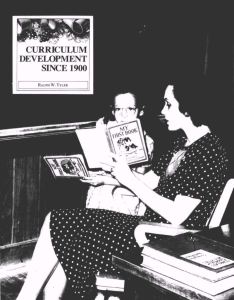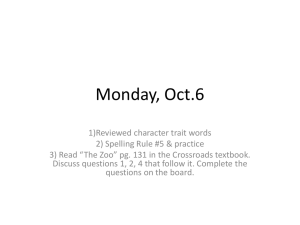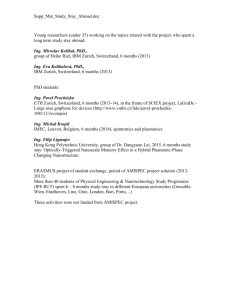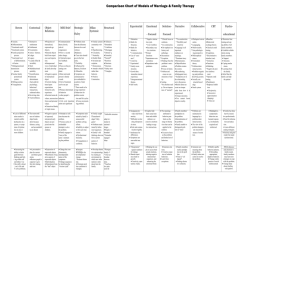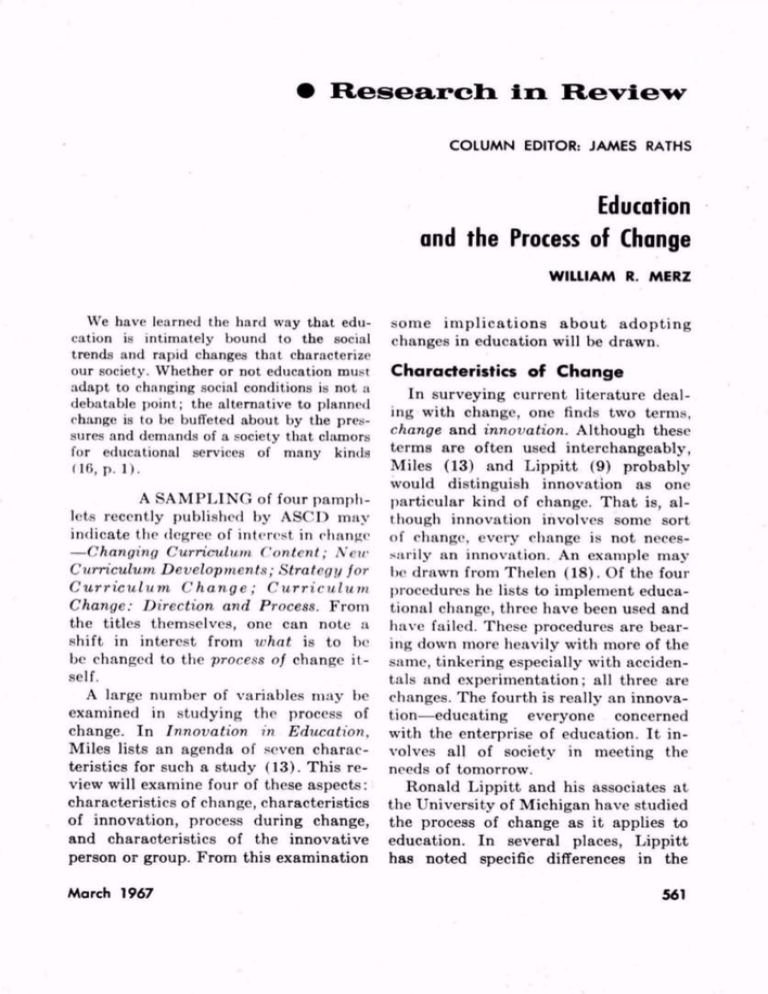
• Research in Review
COLUMN EDITOR: JAMES RATHS
Education
and the Process of Change
WILLIAM R. MERZ
We have learned the hard way that edu
cation is intimately bound to the social
trends and rapid changes that characterize
our society. Whether or not education must
adapt to changing social conditions is not a
debatable point; the alternative to planned
change is to be buffeted about by the pres
sures and demands of a society that clamors
for educational services of many kinds
(16, p. 1).
A SAMPLING of four pamph
lets recently published by ASCD may
indicate the degree of interest in change
Changing Curriculum Content; \euCurriculum Developments; Strategy for
Curriculum Change; Curriculum
Change: Direction and Process. F rom
the titles themselves, one can note a
shift in interest from w hat i s to be
be changed to the process of change it
self.
A large number of variables may be
examined in studying the process of
change. In Innovation in Education,
Miles lists an agenda of seven charac
teristics for such a study (13). This re
view will examine four of these aspects:
characteristics of change, characteristics
of innovation, process during change,
and characteristics of the innovative
person or group. From this examination
March 1 967
some implications about adopting
changes in education will be drawn.
Characteristics of Change
In surveying current literature deal
ing with change, one finds two terms,
change and innovation. Although these
terms are often used interchangeably,
Miles (13) and Lippitt (9) probably
would distinguish innovation as one
particular kind of change. That is, al
though innovation involves some sort
of change, every change is not neces
sarily an innovation. An example may
be drawn from Thelen (18). Of the four
procedures he lists to implement educa
tional change, three have been used and
have failed. These procedures are bear
ing down more heavily with more of the
same, tinkering especially with acciden
tals and experimentation; all three are
changes. The fourth is really an innova
tion educating everyone concerned
with the enterprise of education. It in
volves all of society in meeting the
needs of tomorrow.
Ronald Lippitt and his associates at
the University of Michigan have studied
the process of change as it applies to
education. In several places, Lippitt
has noted specific differences in the
561
adoption of change in the social sciences
as opposed to the adoption of change in
the pure sciences (10). He lists eight
aspects which are unique to the change
process in education.
1. Most changes in practice require
changes in the attitudes, skills, and values
of the practitioner so that the change can
become a useful adoption or adaptation.
2. A large portion of the significant inno
vations in the field of education remain in
visible, undocumented, and inaccessible to
many potential adopters.
3. Under some conditions educators are
expected to be their own inventors, while
under others their colleagues and their ad
ministrators would disapprove.
4. Education lacks a professional net
work of communicators and change agents.
5. Colleagues often are inhibitors to try
ing out or to adopting innovations.
6. Creative working relationships among
social scientists are lacking.
7. Feedback mechanisms to reinforce
change efforts :md to tell educators whether
try-outs are successful are lacking.
8. Administrators and curriculum coordi
nators feel that the community will react
against experimentation (0).
David Clark and Egon Guba present
a model or schema, as they call it, of
the change process (4). Theirs is a four
fold classification system which pro
ceeds from research through develop
ment and diffusion to adoption. In this
taxonomy, school systems are involved
in the diffusion and the adoption pro
cesses.
In other words, schools should be in
volved in the realm of operation. Their
mission is to develop the best possible
operating system. One way to complete
such a mission is presented 'by Robert
Fox in a problem solving approach for
in-service training (6). In this model the
March 1967
establishments to which Broudy refer
red in his 1966 ASCD speech (3) and
the various systems listed by Miles (13*
cooperate in bringing about change.
Characteristics of the Innovation
Typically, there has been a lapse of
fifty years between insight into a need
and introduction of a generally accept
able way of meeting that need, accord
ing to Mort (15). This may be because,
according to Merton and Lerner, there
seem to be two gaps between research
and policy. First, research is not ade
quately focused on the practical prob
lem. Second, concrete forecasts are con
tingent on uncontrolled conditions (14).
However, the tempo of diffusion can be
increased if a public demand is built up,
if professional leadership in the school is
made receptive to the demand, if in
structional materials are inexpensive,
and if instructional materials are all but
self-teaching (15).
In examining the innovations recently
attempted, Thelen maintains that "edu
cation at present focuses too exclusively
on rational processes, on 'objective'
formulations of data and on knowledge
over which there can be no argument be
cause it is the kind of knowledge that
can be authoritatively demonstrated by
culturally given scientific canons of
proof of acceptability" (18, p. 20). If
innovations are based on this focus, we
work with only a small part of human
knowledge and must broaden our view
to the way other kinds of knowledge re
late to education
Processes During Change
At the school level the focus of change
is often on what is being changed and
on who is being changed. Teachers are
563
the target with the driving force coming
from outside the educational system in
volved (6). Rather than emphasizing
the what and who, the how and why of
the change must be stressed. The sec
tion "Goal and Value Dilemmas in the
Planning of Change" by Bennis, Benne
and Chin discusses the conflicts which
people must face in finding, construct
ing, and validating directions of action
(1). The processes may be organized
into several systems; three of which
are mentioned here. First, there is the
classification system of Clark and Cuba
which has four general sections: re
search, development, diffusion, and
adoption. Each section provides differ
ent roles and involves different social
agencies. These authors place the school
in the last two phases: diffusion and
adoption (4).
Second, a demonstration model is
proposed by Henry Brickell. It exam
ines quite carefully the interrelation
ships of the various structures and sub
structures discussed by Miles (13). The
last, which might be called a problem
solving method, is proposed by Robert
Fox. Tins particular approach sees in
novation and change as coming from
a concern in the actual operation of the
educational enterprise (6).
The models themselves are important
insofar as they facilitate the process of
change. Each has advantages and dis
advantages. Each will be useful if it
facilitates the process or insight into
dealing with change. The problem will
be choosing a model appropriate to the
situation being faced so that advantages
are maximized and disadvantages are
minimized.
Educators have looked toward agri
culture for approaches to introduce
March 1967
change. The works of Lionberger (8)
and of Eicholz and Rogers (5) present
a number of interesting comparisons be
tween the change process in agriculture
and that in education. Important simi
larities between the two are listed by
Mackenzie. They are that a direct rela
tionship exists between the innovator''
orientation outside his social system and
his ability to change and that a direct
relationship exists between innovativeness and financial resources (12). Dif
ferences are also mentioned education
lacks scientific sources of innovation;
education lacks agents to promote new
educational ideas; and education lacks
economic incentive for teachers to adopt
innovation (12).
Characteristics of the
Innovative Person or Groups
There are three characteristics of the
innovator which may be drawn from re
search (16, 8, 15). First, the innovator
is not always a respected member
among his peers; second, he values venturesomeness above the esteem of the
group; and third he is not identified as
influential by those around him.
From Pellegrin's discussion of ten
agents which serve as sources for
change, one can draw these generaliza
tions (15). The administrator, specific
ally the superintendent of schools, is the
significant contributor. School boards
and the lay public exercise a braking
influence on innovation. State Depart
ments of Education exercise varying
levels of influence as can be demon
strated in the booklet, R esearch in State
Departments of Education ( 10). The
U.S. Office of Education exerts increas
ing influence. One needs only to review
recent legislative enactments such as the
565
Elementary and Secondary Education
Act.
Textbook publishers exercise a great
deal of control because schools depend
upon them for instructional materials.
However, innovation may not be wel
comed by publishers because they have
a substantial investment in already
marketed programs; as a result, their
influence may be that of reinforcing the
status quo. Educational facilities and
experts in particular specialties are ex
erting a greater influence. Scientists and
mathematicians have been increasingly
influential in science and mathematics
curriculum during the last five years.
Efforts are now being made by the Re
gional Laboratories, established under
Title IV, ESEA, to contribute even
more. Some teacher education institu
tions, on the other hand, have only re
cently become effective in the change
process and this largely with the aid of
the Federal Government and of private
foundation?.
In summary, there is little doubt that
society will continue making demands
of the schools which will necessitate dif
ferent organization in practices from
those which exist today. The question
becomes whether education will con
tinue to be buffeted about by the de
mand placed upon it or will meet its
responsibilities in a rapidly changing
society.
Various models, such as those pre
sented by Brickell, by Clark and Cuba,
and by Fox may be useful conceptual
schemes in organizing for change. Cer
tainly, the work of Rogers in D iffusion
of Innovations ( 17) and the work of
Lippitt, Watson and Westley in the D y
namics of Planned Change ( 11) cannot
March 1967
CONTINENTAL PRESS
now offers your teachers . . .
OVer 200 titleS in preprinted carbon
masters for liquid duplicating
MATHEMATICS (modem, transitional, and
traditional)
ENGLISH
READING READINESS
READING-THINKING SKILLS -PHONICS
SCIENCE — HEALTH — SOCIAL STUDIES
OUTLINE MAPS
GUIDANCE —SPECIAL EDUCATION
Liquid Duplicating Materials...
• ••modern, convenient, effective teaching
aids that provide great flexibility of usage.
No grade level is indicated on the pages
so that the teacher can select materials
from various levels to use according to
students' needs.
For Information about these publica
tions, write for a Complete Catalog.
' THE CONTINENTAL PRESS, INC.
______Elbabethtown, Pa. 17022
be ignored in considering the complex
condition surrounding innovation. Bear
ing down more heavily with more of the
same has not worked. Tinkering, espepecially with the organizational struc
ture, has led to resistance by teachers, by
students, and by communities. Experi
mentation has not often reached out be
yond its own limited scope, and when it
has done so, it has not been believed.
What seems to be needed is a "way of
life" that will enable education to place
new meaning in its quest (18), that will
enable education to be the humane
process.
References
1. W. G. Bennis. K. D. Benne and R. Chin,
compilers. The Planning of Change. New
York: Holt, Rmehart and Winston, Inc.,
1961.
2. H. M. Brickell. Orgamting New York
State jor Educational Change. New York:
567
State Education Department, 1961. Also in
M. B. Miles, compiler. I nnovation in Educa
tion. New York: Bureau of Publications,
Teachers College, Columbia University, 1964.
3. H. S. Broudy. "Needed: A Unifying
Theory of Education." In: Curriculum
Change: Direction und Process. Washington.
D. C.: Association for Supervision and Cur
riculum Development, 1966.
4. D. L. Clark and E. Cuba "An Examina
tion of Potential Change Roles in Educa
tion." Seminar on Innovation in Planning
School Curricula. October 1965
5. G. Eicholz and E. M. Rogers. "Resist
ance to the Adoption of Audio-Visual Aids
by Elementary School Teachers: Contrasts
and Similarities to Agricultural Innovation."
In: Innovation in Education, op. cil.
6. Robert S. Fox. "In-Servicc Education
for Innovation and Change." Mimeographed
paper delivered at Conference on The Role of
Demonstration
Centers
in
Educational
Change. Urbana, Illinois. February 1966.
7. R. S. Fox and R. Lippitt. "The Innova
tion of Classroom Mental Health Practices."
In: I nnovation in Education, op. cit.
8. H. F. Lionberger. "Diffusion of Innova
tions in Agricultural Research and in
Schools." In: Strategy for Curriculum
Change. Washington, D. C.: Association for
Supervision and Curriculum Development.
1965.
9. R. Lippitt. "Roles and Processes in Cur
riculum Development and Change." In:
Strategy for Curriculum Change, op. cil.
10. R. Lippitt. "The Use of Social Research
to Improve Social Practice." A merican Jour
nal ol Orthopsychiatry 35: 663-69; July 1965
11. R. Lippitt, J. Watson and B. Westley.
The Dynamics of Planned Change. New
York: Harcourt. Brace & W orld. Inc., 1958.
12. G. N. Mackenzie. "Curricular Change:
Participants, Powers, and Process." In: Inno
vation in Education, op. cit.
13. Matthew B. Miles. "Educational Inno
vation: The Nature of the Problem." In:
Innovation in Education, op. ctt.
14. R. K. Merton and D. Lerner. "Social
Scientists and Research Policy." In: The
Planning of Change, op. cit.
15. Paul Mort. "Studies in Educational In
novation from the Institute of Administrative
Research: An Overview." In: Innovation ? n
Education, op. cit.
16. Roland J. Pellegrin. "An Analysis of
Sources and Processes of Innovation in Edu
cation." Mimeographed paper delivered at
Conference on the Role of Demonstration
Centers in Educational Change, Urbana, Illi
nois. February 1966.
17. E. M. Rogers. D iffusion of Innovations.
Xew York: Free Press, 1962.
18. H. Thelen. Education and the Human
Quest. New York: Harper & Row Publishers.
Inc., 1960.
19. U. S. Department of Health. Education.
:md Welfare. Office of Education. R esearch in
State Departments oj Education. Washington,
D. C.; Government Printing Office. Bulletin
26. 1965.
WILLIAM R. MERZ. imperial Assist
ant. Clark County Schools. Las Vegas,
Nevada.
The Humanities and the Curriculum
Papers from a conference sponsored by the ASCD
Commission on Current Curriculum Developments
8S; Price: $2.00
Association for Supervision and Curriculum Development
1201 Sixteenth Street, N.W., Washington, D.C. 20036
March 1 967
569
Copyright © 1967 by the Association for Supervision and Curriculum
Development. All rights reserved.


